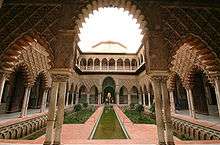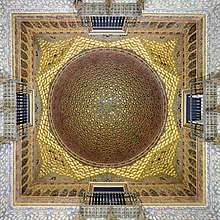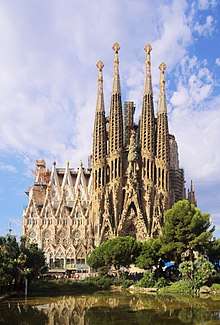Alcázar
An alcázar (English: /ˈælkəzɑːr/;[2] see below) is a type of Moorish castle or palace in Spain and Portugal built during Muslim rule although the term is also used for many medieval castles built by Christians on earlier Roman, Visigothic or Moorish fortifications. Most of the alcázars were built between the 8th and 15th centuries. Many cities in Spain have an alcázar. The term is frequently used as a synonym for castillo or castle; palaces built by Christian rulers were also often called alcázars.


.jpg)
Terminology
The Spanish word alcázar (pronounced [alˈkaθaɾ]) derives from the Arabic word القصر al-qaṣr "the fort, castle, or palace".[3], which in turn derives from the latin word Castrum ("fortress", "military camp").
Similar words exist in Galician (alcázar, pronounced [alˈkaθɐɾ]), Portuguese (alcácer, pronounced [ɐɫˈkasɛɾ]), and Catalan (alcàsser, pronounced [əlˈkasəɾ]).
Spain also has Moorish citadels known as alcazabas (القصبة al-qasbah). However, not all castles in Spain are called alcázar: the majority are called castillo in Spanish or castell in Catalan. Nor was every alcázar or alcazaba in Iberia built by the Moors: many castles with these names were built after the Moors were expelled from the Iberian Peninsula.
Landmark alcázars
- Alcázar of Segovia was first cited in the 12th century, though its foundations date back to Roman times. It is a castle built by the Christian monarchs in the place of a Moorish fort. During the Middle Ages when in the Kingdom of Castile, the alcázar of Segovia was the favorite residence of the Castilian monarchs, and almost each king added new parts to the building, transforming the original fortress into a courtier residence and prolonging the construction of the castle until the 16th century, when king Philip II added the conical spires and the slate roofs. A fire in 1862 destroyed part of the roofs, but they were restored in the very same style in which they were built 300 years before. In this castle there was the proclamation of Isabella I as queen of Castile in 1474 starting the War of the Castilian Succession.
- Alcázar of Toledo was used as a military academy in modern times. The Siege of the Alcázar in the Spanish Civil War references this castle, which was held by the Nationalist colonel José Moscardó Ituarte against Republican forces. Republican forces captured Moscardó's 24-year-old son Luis, and on 23 July 1936 informed Moscardó that if he did not turn over the alcázar within ten minutes his son would die. When Moscardó did not surrender, Luis was murdered, not immediately but one month later, on 23 August.[4]
- Alcázar of Seville, on the site of the palace of the Almohad Caliphate called al-Muwarak, was built in the 1360s by Christian Castilian craftsmen in Mudéjar style, and frequently remodeled. It was first used by Peter of Castile with his mistress María de Padilla. The structures and gardens are a UNESCO World Heritage Site.
- Alcázar de los Reyes Cristianos, also called "the Alcázar of Córdoba", in Córdoba, Andalusia was a Moorish palace after the 13th century Reconquista of Córdoba. The Moors had expanded a Visigoth fortress into a large compound with gardens and a large library.[5] This alcázar was the summer home of King Ferdinand and Queen Isabella, and the site of their meeting with Christopher Columbus before his famous voyage to the Americas.
- Alcázar of Jerez de la Frontera.
- Castle of Burgos, today just remains of that was once an alcázar and a royal residence.
- The Alhambra in Granada.
Disappeared landmark alcázars
- The Alcázar of the Caliphs of Córdoba was the seat of the government of Al-Andalus, and the residence of the emirs and caliphs of Córdoba since the arrival of the Muslims in the 8th Century until the Christian conquest of the city, in 1236. It had a total area of 39,000 square metres (420,000 sq ft). Part of its structure survives.
- The Royal Alcazar of Madrid was a palace built by Emperor Charles V, Holy Roman Emperor, (rebuilt by his son, Philip II)[6] and was the main royal residence in Madrid until the Buen Retiro Palace partly superseded it in the 17th century. It was destroyed by fire in 1734, and the present Royal Palace of Madrid was built on the site. This was called Palacio Nuevo and has never been called alcázar.
- The Castle Alcázar of Segorbe, province of Castellón, autonomous community of Valencia, was an enormous complex that for over a thousand years was the residence of lords, dukes and kings.
Outside Spain
Outside Spain, in Palermo, Sicily, the district called Cassaro corresponds to the Punic settlement of Zis, on high ground that was refortified by Arabs and known as al-qaṣr, and was further expanded as the site of the later Norman palace.
In Portugal there is a city called Alcácer do Sal that was an administrative regional seat for the Moors of al-Andalus.
The former colonial palace in Santo Domingo, originally built for Christopher Columbus's son Diego in 1509, is commonly known as the Alcázar de Colón ("Columbus's alcázar") and is built in the Andalusian style.
See also
- Alcazaba
- Kremlin (fortification)
- Moorish Castle, Gibraltar
Notes
- اليوم, الدمام- (2015-01-09). "صحن الوصيفات في قصر المورق بغرناطة". alyaum (in Arabic). Retrieved 2020-04-07.
- "Alcazar". Dictionary.com Unabridged. 10 Oct 2015.
- "alcazar | Definition of alcazar in English by Oxford Dictionaries". Oxford Dictionaries | English. Missing or empty
|url=(help) - Hugh Thomas, The Spanish Civil War, revised and enlarged edition (1977), New York: Harper & Row. ISBN 0-06-014278-2. p. 324
- Reed, Tony (2005). "Alcazar de los Reyes Cristianos - Cordoba". Infocordoba.com. Archived from the original on 11 May 2006. Retrieved April 4, 2006.
- Philip of Spain by Henry Kamen

